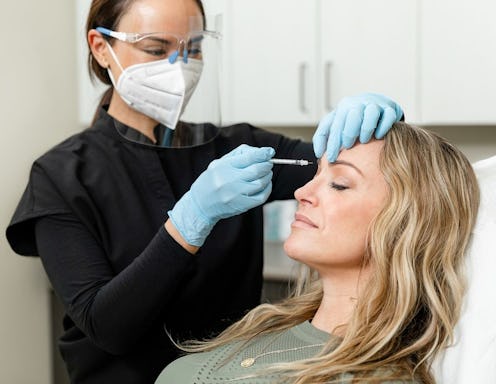(Procedures)
If You’ve Been Considering Under Eye Filler, The Injectable Just Got A Bit Safer
This just in.

It’s a fact: We live in a cosmetically enhanced world. In 2022 you’d be hard-pressed to find someone that hasn’t gotten or, at the very least, considered getting injectables. While some celebrities are notoriously tigh-lipped about what they’ve had done, others like Chrissy Teigen and Khloe Kardashian keep it real. Procedures like Botox and filler both offer long lasting results and help to treat wrinkles among other skin concerns. Neuromodulators like Botox freezes the muscles near these wrinkles, while fillers add volume to sunken areas or help to build structure.
Under eye fillers involve injecting hyaluronic acid-based filler into the skin underneath the eyes — an area which is often plagued with dark circles, bags, and wrinkles. Until yesterday, under eye filler has been injected “off label” — meaning that it wasn’t FDA-approved to treat under eye bags. But as of Feb. 8, the FDA has given Juvéderm Volbella XC, a popular type of filler, its seal of approval for undereye usage.
“A lot of filler is used off label for years before it gets FDA approval for a certain indication,” Dr. Nancy Samolitis, a Board Certified Dermatologist and owner of Facile Skin, says to TZR. That’s why, the doctor explains, we already have existing data on the safety and efficacy in anecdotal reports. “But now that information is available for the public to have that reassurance,” adds Dr. Samolitis.
If you’re someone that constantly looks tired or has chronic bags, this development is a game-changer. It’s one of the most effective ways to eliminate that hollowness below the bottom lash line. "A very small amount of product is needed for the tear troughs, and the placement needs to be very precise, with your practitioner injecting slowly and methodically for the best results," SkinSpirit Co-Founder and Vice President of nursing Cara Fonteyne explains in a press email.
As you can imagine, it’s a very small circumference area that’s being treated and the skin in that area is very sensitive. That’s why it’s paramount to find an injector that knows their stuff. "Many practitioners get caught in the trap of using too much filler, only to make the problem worse in the future," warns Fonteyne. “The tissue there can be unforgiving and too much filler can cause problems like lumps, bumps, or persistent swelling,” adds Dr. Samolitis. In fact, it’s the reason, she says, she typically does few sessions of small amounts until the patient is happy with the result.
Like all other injectables, under eye filler is an investment. “The cost varies from $600-$1500 based upon what brand of filler you select and number of syringes,” Newport Beach-based board-certified public surgeon and ENT specialist Dr. Kevin Sadati, M.D. shares with TZR. It’s worth noting that you have to purchase filler by the syringe (even though you might only need a tiny portion to fill the under-eye area). “If you do not use the full syringe, you can use it on other areas such as the cheeks, lips, jawline, chin or even for neck, chest, or hand rejuvenation,” suggests Dr. Sadati.
As far as maintenance, there’s no one answer for how often you have to get touch ups. “It will vary based upon the type of filler and how quickly the body absorbs the product,” explains Dr. Sadati. That being said, Dr. Samolitis says filler in the under eye area seems to last longer than many other areas. “In fact, I've seen some under eye filler last 5-plus years,” she shares. “Simple things like staying hydrated and sleeping on your back can help make the filler last longer,” advises Dr. Sadati.
While under eye filler has been lauded by many as a miracle, not everyone is a candidate. Fonteyne notes that the right patient should possess three main qualities: good cheek support, not be prone to under eye swelling, (due to allergies, water retention, improper lymphatic drainage, etc.) or have an absence of prolapsed fat pads and loose skin under the eyes.
If you are a candidate however and have been thinking about going under the needle, this FDA approval means you can do so, with much more peace of mind about the safety of the procedure.
This article was originally published on